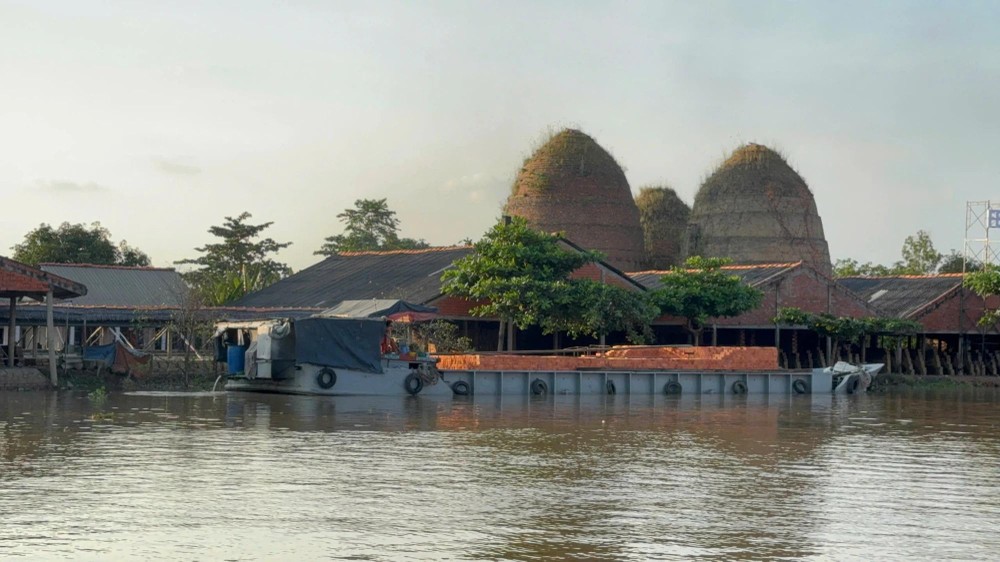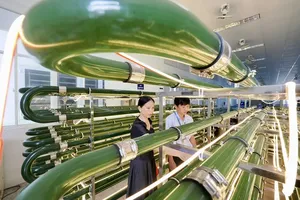
Accordingly, the planning area has a scale of about 3,060 hectares. The scope and boundary of the planning area are in the communes of My An, My Phuoc, Nhon Phu and Hoa Tinh of Mang Thit District.
The Mang Thit Brick and Pottery Kiln Area, also referred to as the Brick and Pottery Village in Mang Thit District, was established over a century ago and is renowned as the largest and most prominent red brick and pottery production hub in the Mekong Delta region.
In its heyday, the brick and pottery village stretched 30km across Vinh Long City, Long Ho District and Mang Thit District with more than 3,000 operating kilns. Currently, there are only about 800 brick and pottery kilns remaining, covering an area of 3,000 hectares, most of which are located along the Thay Cai Canal to the section bordering the Co Chien River - a branch of the Mekong River.
In the 1980s, this village thrived on brick and ceramic production, lifting thousands out of poverty. Its products were distributed nationwide and even exported.
Le Van Lon, a brick and red ceramic industry veteran with over 40 years of experience in Vinh Long Province's Mang Thit District stated that his family owns two brick kilns. These kilns are constructed from thousands of evenly arranged bricks, built in a circular tower architecture that tapers towards the top, containing a total of 30,000 bricks.
According to him, on average, a batch of bricks produced in 40 days would produce 25,000 bricks, the raw material for firing was rice husk ash. He disclosed that prior to the introduction of unfired bricks and integrated brick kilns, the production capacity of the village could not meet the prevailing market demand. However, the advent of these new technologies has resulted in a decline in the production and sales of traditional handmade bricks.



Consequently, profitability has diminished, with the majority of sales now reliant on established customer relationships. Nevertheless, high production costs necessitate low selling prices, significantly impacting overall profitability.
In the village, each family has 2-5 kilns, each with a capacity of about 15,000 bricks.
In the past, the process of kneading soil and molding was done by hand, but today people have invested in machines, which reduces a lot of time and labor, saving production costs.
For instance, Ba Dinh, a famous brick kiln owner in the village, invested in a continuous kiln with 59 mouths (doors), each mouth containing 7,000 to 8,000 bricks. This type of kiln takes about 8 hours to produce finished bricks.
With the advent of modern technology, some kilns ceased operations, unable to invest in upgraded production lines. Over time, these abandoned brick kilns became cloaked in moss and overgrown with weeds, transforming into picturesque and romantic landscapes that now draw many visitors for photography.
Viewed from above, the cluster of brick kilns nestled closely together resembles a "kingdom" of hundreds of tiny "castles" lining the Thay Cai Canal. The daily movement of countless ferries adds vibrant hues to the serene, rustic charm of the countryside. This distinctive setting has played a significant role in promoting tourism in Vinh Long Province, drawing on the heritage and timeless allure of the century-old brick kilns.
Director Phan Van Giau of the Department of Culture, Sports and Tourism of Vinh Long Province has announced that the provincial government will introduce specific support measures for the preservation of brick and pottery kilns. These measures will include partial financial assistance to individuals engaged in the preservation of traditional kilns, with the overarching objective of maintaining the integrity of this significant heritage area for future generations.
Under the plan, the Mang Thit Brick and Pottery Kiln Area is set to become a major tourist destination for the province, with aspirations to develop it into a national-level tourist attraction. This initiative is expected to play a vital role in driving socio-economic development, particularly boosting tourism in Vinh Long specifically and the Mekong Delta region as a whole.












)






















